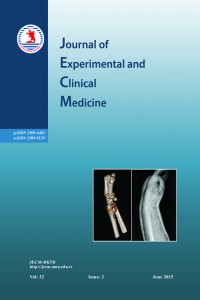Research Article
Year 2015,
Volume: 32 Issue: 2, 85 - 89, 25.06.2015
Abstract
References
- Cheng, J.C., Shen, W.Y., 1993. Limb fracture pattern in different pediatric age groups: A study of 3350 children. J. Orthop. Trauma. 7, 15-22.
- Houshian, S., Holst, A.K., Larsen, M.S., Torfing, T., 2004. Remodeling of Salter Harris type II epiphyseal plate injury of the distal radius. J. Pediatr. Orthop. 24, 472-476.
- Jones, I.E., Williams, S.M., Dow, N., Goulding, A., 2002. How many children remain fracture-free during growth? A longitudinal study of children and adolescent. Osteoporos. Int. 13, 990-995.
- Jordan, R.W., Westacott, D.J., 2012. Displaced paediatric distal radius fractures-when should we use percutaneous wires? Injury. 43, 908-911. doi: 10.1016/j.injury.2012.01.006.
- Khosla, S., Melton, L.J., Dekutoski, M.B., Achenbach, S.J., Oberg, A.L., Riggs, B.L., 2003. Incidence of childhood distal forearm fractures over 30 years: A population-based study. JAMA. 290, 1479-1485.
- Miller, B.S., Taylor, B., Widmann, R.F., Bae, D.S., Snyder, B.D., Waters, P.M., 2005. Cast immobilization versus percutaneous pin fixation, of displaced distal radius fractures in children:a prospective randomized study. J. Pediatr. Orthop. 25, 490-494.
- Mizuta, T., Benson, W.M., Foster, B.K., Paterson, D.C., Morris, L.L., 1987. Statistical analysis of the incidence of physeal injuries. J. Pediatr. Orthop. 7, 518-523.
- Niver, G.E., Ilyas, A.M., 2012. Carpal tunnel syndrome after distal radius fracture. Orthop. Clin. North Am. 43, 521-527. doi: 10.1016/j. ocl.2012.07.021.
- Peterson, H.A., 2013. Physeal fractures: Part 2. Two previously unclassified types. J. Pediatr. Orthop. 33, 438-448.
- Rang, M., 1993. Injuries of the epiphysis, growth plate and perichondral ring. Children’s Fractures, Philadelphia JB. Lippincott: 23.
- Salter, R.B., 1992. Injuries of the epiphyseal plate. Instr. Course Lect. 41, 351-359.
- Stutz, C., Mencio, G.A., 2010. Fractures of the distal radius and ulna: Metaphyseal and physeal injuries. J. Pediatr. Orthop. 30 suppl; 85-89.
- Waters, P.M., Kolettis, G.J., Schwend, R., 1994. Acute median neuropathy following physeal fractures of the distal radius. J. Pediatr. Orthop. 14, 173-177.
- Waters, P.M., Miller, B., Taylor, B., 2000. Prospective study of displaced radius fractures in adoloscents treated with casting vs. percutaneous pinning. AAOS Annual Meeting.
- II, the periosteal integrity of the metaphyseal fragment had
- been lost (Thurston Holland Sign). Median nerve lesion
- accompanying this type of fracture may be a specific event.
- In contrast to Type II injuries which can almost all be treated
- conservatively, surgical treatment is required.
Year 2015,
Volume: 32 Issue: 2, 85 - 89, 25.06.2015
Abstract
Distal radius epiphyseal injuries are common fractures in childhood. Displaced physeal fractures are at risk for development of median neuropathy. We have described similar type of physeal injury in two adolescent patients with median nerve neuropathy. Because of the loss of periosteal integrity in metaphyseal region, these injuries are unique which can be accepted as a variant of Salter Harris Type 2. The patients were treated surgically and the median nerve symptoms resolved. At the final follow-up the patients were symptom free and there was no growth disturbance or deformity. |
References
- Cheng, J.C., Shen, W.Y., 1993. Limb fracture pattern in different pediatric age groups: A study of 3350 children. J. Orthop. Trauma. 7, 15-22.
- Houshian, S., Holst, A.K., Larsen, M.S., Torfing, T., 2004. Remodeling of Salter Harris type II epiphyseal plate injury of the distal radius. J. Pediatr. Orthop. 24, 472-476.
- Jones, I.E., Williams, S.M., Dow, N., Goulding, A., 2002. How many children remain fracture-free during growth? A longitudinal study of children and adolescent. Osteoporos. Int. 13, 990-995.
- Jordan, R.W., Westacott, D.J., 2012. Displaced paediatric distal radius fractures-when should we use percutaneous wires? Injury. 43, 908-911. doi: 10.1016/j.injury.2012.01.006.
- Khosla, S., Melton, L.J., Dekutoski, M.B., Achenbach, S.J., Oberg, A.L., Riggs, B.L., 2003. Incidence of childhood distal forearm fractures over 30 years: A population-based study. JAMA. 290, 1479-1485.
- Miller, B.S., Taylor, B., Widmann, R.F., Bae, D.S., Snyder, B.D., Waters, P.M., 2005. Cast immobilization versus percutaneous pin fixation, of displaced distal radius fractures in children:a prospective randomized study. J. Pediatr. Orthop. 25, 490-494.
- Mizuta, T., Benson, W.M., Foster, B.K., Paterson, D.C., Morris, L.L., 1987. Statistical analysis of the incidence of physeal injuries. J. Pediatr. Orthop. 7, 518-523.
- Niver, G.E., Ilyas, A.M., 2012. Carpal tunnel syndrome after distal radius fracture. Orthop. Clin. North Am. 43, 521-527. doi: 10.1016/j. ocl.2012.07.021.
- Peterson, H.A., 2013. Physeal fractures: Part 2. Two previously unclassified types. J. Pediatr. Orthop. 33, 438-448.
- Rang, M., 1993. Injuries of the epiphysis, growth plate and perichondral ring. Children’s Fractures, Philadelphia JB. Lippincott: 23.
- Salter, R.B., 1992. Injuries of the epiphyseal plate. Instr. Course Lect. 41, 351-359.
- Stutz, C., Mencio, G.A., 2010. Fractures of the distal radius and ulna: Metaphyseal and physeal injuries. J. Pediatr. Orthop. 30 suppl; 85-89.
- Waters, P.M., Kolettis, G.J., Schwend, R., 1994. Acute median neuropathy following physeal fractures of the distal radius. J. Pediatr. Orthop. 14, 173-177.
- Waters, P.M., Miller, B., Taylor, B., 2000. Prospective study of displaced radius fractures in adoloscents treated with casting vs. percutaneous pinning. AAOS Annual Meeting.
- II, the periosteal integrity of the metaphyseal fragment had
- been lost (Thurston Holland Sign). Median nerve lesion
- accompanying this type of fracture may be a specific event.
- In contrast to Type II injuries which can almost all be treated
- conservatively, surgical treatment is required.
There are 19 citations in total.
Details
| Primary Language | English |
|---|---|
| Subjects | Health Care Administration |
| Journal Section | Research Article |
| Authors | |
| Publication Date | June 25, 2015 |
| Submission Date | April 11, 2014 |
| Published in Issue | Year 2015 Volume: 32 Issue: 2 |
Cite

This work is licensed under a Creative Commons Attribution-NonCommercial 4.0 International License.

